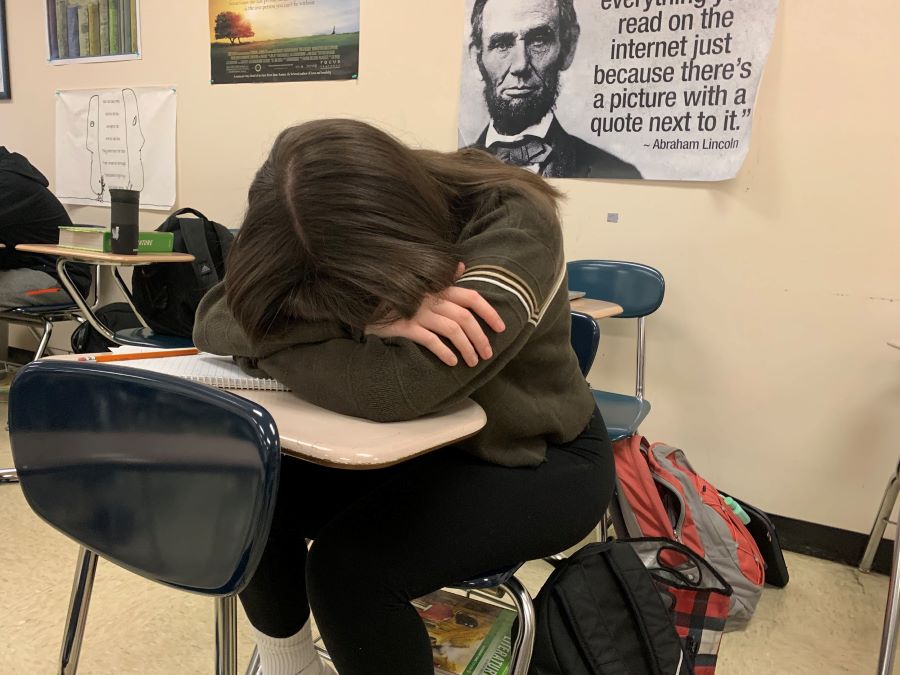The Pros and Cons of a School-Wide Nap Time
Students in high school often struggle to stay awake during difficult classes.
March 2, 2020
A Student’s Struggle Between Sleep and Studying
At first glance, a school-wide nap time seems like an unrealistic idea that students would blindly support simply due to the prospect of less class time each day. However, many students struggle to focus or even stay awake throughout the entire school day. It’s not uncommon to see students walking the halls with coffee or soda in hand as they make their way to class, hoping they won’t need a nap by the end of the day. Unfortunately, students all across the school feel the urge to lay their head down or “rest their eyes” for a moment during the day despite the action being against school policy. It is clear to see that students do not regularly get enough rest at night, and although most adults would simply suggest an earlier bedtime, this has proven to be nearly impossible for some young adults. It is important to recognize the students of Karns as young adults because they are definitely not little kids anymore; they have plenty of responsibilities that take time away from their after school life, such as jobs.
In an interview with a current Junior and HOSA member at Karns High, Mia Thompson, she says, “I normally work from around either 4 or 4:30 to like nine, so it can range anywhere from like four to five and a half hours on a weekday, so I stay tired.” Many students across Karns High have jobs they are required to go to, but if they do not currently have a job they are more than likely involved in some sort of extracurricular activity. Additionally, the heavy weight of advanced courses and the amount of homework given pushes the students into staying awake later and later to fulfil these responsibilities. Mia Thompson claimed that she has to stay up longer to finish homework nearly every night, but one student has a different approach to the issue. Meredith McNeeley, a well accomplished student who is Junior class president, TSA secretary, ensemble historian and also a member of the cheer team, NHS and musical theater said, “I would say sometimes. I try and give myself a two hour window and if it’s not done by 11pm, it just doesn’t get done. I think sleep is more important to be able to function for a whole day rather than one assignment.” Obviously, rest is important for the young minds of teenagers, and some students realize this and are adamant about getting enough sleep to keep their focus the next day. Unfortunately, students are penalized for unfinished assignments if they choose sleep over academics, and most students are more concerned about how their grades affect them rather than how a healthy amount of sleep does.
In light of this, two options surface as possible solutions to the lack of sleep students are getting: less work for them to complete outside of school, or a school-wide nap time. As of right now, the only break students get throughout the school day is the 25 minute lunch break, and normally that is just enough time for these young adults to eat and socialize a bit. In theory, a quick 20-30 minute nap in the middle of the school day would refresh students enough to get them through the remainder of their classes and ensure they can focus and stay awake. However, it would be extremely difficult to find support for this and even harder to work out smaller details such as the time of day, how it will affect other classes, where students will be expected to stay, and how to keep students from chatting with friends or spending the time on their phones. It is unfortunate that students have difficulty juggling school work, extracurriculars and maintaining a regular sleep schedule, so it is important that solutions are proposed. For now, regulating the amount of homework students are required to do or having a school sanctioned nap time are two options that should be considered.





the dark lord • Mar 11, 2024 at 3:45 pm
bro why couldn’t it talk more about behavior stuff
boom • Feb 12, 2025 at 1:17 pm
boom